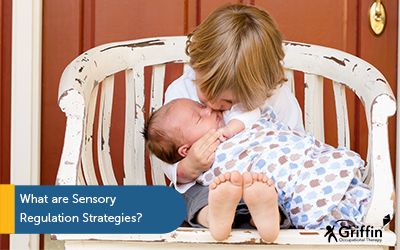Understanding sensory processing or integration
Sensory Processing Disorder (SPD) is a term that describes the experiences children (and adults) have when their brains are not interpreting the sensory messages received from their body effectively. It can affect or interrupt the messages received from of the senses. You may also hear the term ‘sensory integration dysfunction’ used as well. In this article I will explore

Understanding sensory processing or integration
Sensory Processing Disorder (SPD) is a term that describes the experiences children (and adults) have when their brains are not interpreting the sensory messages received from their body effectively. It can affect or interrupt the messages received from of the senses. You may also hear the term ‘sensory integration dysfunction’ used as well. In this article I will explore
Interpreting Sensory Messages
As I said above, Sensory Processing Disorder (SPD) describes the differences children (and adults) experience when their brain interprets the sensory information received from their senses differently. It can affect or interrupt the messages from any sense. Because the brain is interpreting sensory messages differently, responses to sensory information may not be what is expected by others (Bialer & Miller 2011). It may also result in poor coordination or dyspraxia.
The terms Sensory Integration Dysfunction or Sensory Integration Disorder may also be used by occupational therapists to describe these difficulties. Autistic children and adults frequently experience sensory processing issues. On this page I will describe what sensory information is and the different sensory issues that may present for children (and adults) with sensory processing challenges. You can ready more about sensory processing and autism here.
Sensory Processing Disorder – What is sensory information?
Sensory information is any message that we receive from our senses. This includes the five senses that most of us are familiar with, taste, smell, sight, hearing, and touch. It addition, we receive information from our proprioceptive and vestibular senses.
Learn more!
If you want to explore the senses in further depth – you can join my free introduction to sensory processing here.

Olivia’s story – sensory slow
Olivia doesn’t always notice what’s happening in the room. Often, she doesn’t respond to her name. Sometimes it seems like she is oblivious to the world around her. Her movements are slower and a bit clumsy. She needs encouragement to have a go and to try activities that her friends just automatically start. Overall, her responses to the sensory messages she receives from the world are slower when compared to others.
What happens when there are sensory processing issues?
The senses of children (and adults) with SPD still receive sensory messages, this means there are usually no problems with their vision or hearing or touch sense. However, their brain processes the sensory information differently to those who do not have sensory issues. It is thought that their brain does not integrate, or process, sensory information in the same way as others.
This means that their responses to sensory information might not always be what is expected by others. It may also mean they find some environments or activities more challenging. This is because a child (or adult) might find certain sensory information too intense and be overwhelmed. Or, they need might need stronger messages from their senses, and seek out more sensory input. Some children might not even notice the sensory events happening around them.
I explore these responses in more depth on our page signs and symptoms of sensory processing disorder. Here, I list some of the common behaviours seen if someone has poor sensory integration or sensory issues.
One thing that is very important to remember is that for children and adults who report sensory issues is that the experiences are very real for them. They are not right or wrong, correct or incorrect. It just just how their own brain interprets sensory messages. This can be very different to how others interpret the same sensory information. Even if it occurs at the same time and place. When supporting children or adults with sensory processing disorders you must remember this. Their responses are neurologically triggered and sometimes out of the person’s control, for example, running off if there is a loud noise without considering safety.
This video describes sensory processing difficulties from a child’s perspective:
What are the components of Sensory Processing Disorder (SPD)?
Lucy Miller (2014) has identified three parts to SPD:

SPD – Sensory modulation
The first component of Sensory Processing Disorder is modulation. Sensory modulation is the ability to produce a behaviour and/or response that matches the nature and intensity of the sensory input and environment (Lucy Miller 2014 p.14). This means that the response to the sensory messages is what would be expected; it would match what had occurred. The responses of children and adults with SPD often do not match the sensory message or environment. There can be challenges with some or all senses. Sensory issues related to modulation difficulties can include:
- Over-responsivity, or sensitivity to sensory input;
- Under-responsivity or not responding to sensory input;
- Craving or seeking out extra sensory input.
I discuss these responses in more depth on this page: signs and symptoms of sensory issues.
Sensory modulation is also called sensory reactivity by some therapists. These therapists will consider hypo and hyper reactivity. So, a slower (hypo) reaction. Or, a bigger (hyper) reaction. Reactivity is being used to bring terminology inline with the 2013 update of the autism diagnostic criteria in a book called the DSM-V.
SPD – Sensory discrimination
The second component of SPD is discrimination. Sensory discrimination is knowing what the sensory input was, where it happened and how intense it was. So, if you stub your toe your brain should be able to figure out (or discriminate) which toe it was and how hard you banged it. When you put your hand into your bag to find your keys, your touch sense can identify (or discriminate) the feeling of your phone and wallet from your keys. When you open a pot of yogurt your proprioceptive system pulls the lid with enough force to open it but hopefully not spill it everywhere! These are examples of discrimination.
Some therapists will use the term sensory perception when they are talking about sensory discrimination.
SPD – Sensory-based movement
The third component of SPD is sensory-based movement. In this section, Miller (2041) includes praxis and posture. Praxis is the ability to plan and organise new and novel movements. It is exceptionally important for learning new skills. People are often more familiar with the term dyspraxia which means difficulty with praxis or planning. Posture relates to postural control, balance and stability.
You can read more about how these sensory processing challenges could look for different children on our signs and symptoms of sensory issues page. If you wanted to learn more about dyspraxia you can read our post – Dyspraxia it’s more than clumsiness.

Harry’s story – dyspraxia
Sensory processing differences don’t always present as a modulation difficulty. Sometimes, it might be that the child has dyspraxia. Harry for example finds learning new activities extremely difficult. He doesn’t join in with his friends in the playground as he doesn’t know what to do. And, he finds the fast movement when they run around hard to understand. His mother describes him as clumsy. Harry’s teacher has also noticed he finds handwriting and using scissors much harder than his peers.
What causes Sensory Processing Differences
Preliminary research from the STAR institute and colleagues suggests that Sensory Processing Differences are often inherited. This means, the causes of SPD are coded into the child’s genetic material at birth. In addition, prenatal and birth complications or risk factors, such as being premature, may also cause SPD. Environmental factors may be involved. For example, children who are adopted often experience SPD, due perhaps to restrictions in their early lives or poor prenatal care.
Why is sensory processing important?
The sensory information that our body receives forms the basis for our decision making. If our brain isn’t processing this information accurately, or if it isn’t able to ignore things that aren’t important, it is much harder for us to produce an appropriate response. You can compare it to a computer. The input comes from the mouse, keyboard and maybe smart screen. The operating system processes the input and then something is produced. If the operating system isn’t working properly then we might not be able to print or send an email or upload a blog post. The outcome is not what we had hoped.
In sensory processing, the brain is like the operating system. The brain must pay enough attention to the right message and organising it in a way it can be used. If it’s not sending the sensory messages to the right place, then the response (typically behaviour) may not be appropriate. It could be unsafe, for example, running across a busy road if there is a loud noise. The response might also lead to errors, such as breaking a toy because you accidentally used too much force. When sensory processing issues occur the sensory messages aren’t connecting smoothly which leads to unexpected responses.
Does Sensory Processing Disorder exist as a standalone diagnosis?
Whilst a large number of professionals and therapists refer to SPD, currently it is not formally recognised as a standalone diagnosis. None of the official diagnostic manuals (e.g. DSM-V or ICD-11) include SPD. This can be very confusing as many doctors and therapists will use the term SPD or sensory issues. The will also include it as a diagnosis on reports and letters. The term Sensory Processing Disorder is widely used. However, it is technically not a standalone diagnosis. Despite this, there are many teams of researchers working towards having Sensory Processing Disorder recognised as a diagnosis in its own right. It may be next time the diagnostic manuals are revised there will be sufficient evidence to have it included.
Is there a difference between sensory processing disorder and autism/Asperger’s?
It is, however, recognised that autistic children experience difficulties with processing sensory information, especially with regards to sensory modulation. We describe sensory modulation further below. The DSM-V autism diagnostic criteria states that there may be “Hyper- or hyporeactivity to sensory input or unusual interests in sensory aspects of the environment. E.g., apparent indifference to pain/temperature, adverse response to specific sounds or textures, excessive smelling or touching of objects, visual fascination with lights or movement.” It is fantastic that this has been recognised within the fifth revision as it is the first time that sensory issues in autism have been formally recognised. There are also researchers looking at sensory processing issues in ADHD, Down’s Syndrome, Fragile X and other disorders.
Sensory differences can impact the responses a child or adult may have to the environment or activity. The outward response is typically behaviour. It is helpful to consider what the sensory triggers might be, as supporting these can help to change the individual’s responses.
What’s the difference between Sensory Integration (SI) and SPD?
SPD and SI refer to the same theory and information. To give justice to their history, similarities, and differences, we have written a separate article on this topic ‘Sensory Integration or Sensory Processing‘ you can read it by clicking the link.
How can I get help if I think myself or my child has sensory issues?
The best placed professional to help to identify if your child has any challenges with their sensory processing is an occupational therapist who has additional training in sensory integration. GriffinOT also offers online sensory screens for our families and adult assessments in the UK .
Where can I find more information on SPD?
Online Sensory Processing Disorder training
My online training is designed to help you to understand the sensory systems and sensory issues in more depth. The free introduction covers the basics. The longer courses explore sensory responses, arousal and support strategies in further depth. You can find out more information about all courses on the course page here.
Websites with useful information
- The GriffinOT website provides more information on sensory differences. You can view these articles here.
- We also explore different sensory equipment and supports. Use this link to find out more.
- The STAR Institute website includes a lot of useful information and updates on current research.
- The Sensory Integration Global Network (SIGN) outlines further information and current research on Ayres’ sensory integration.
Parent-friendly books on SPD
- For a good introduction to Sensory Processing Disorder: The Everything Parent’s Guide to Sensory Processing Disorder by Terri Mauro (2014)
- Another good introduction to Sensory Processing Disorder: The Out of Sync Child by Carol Kranowitz (2005)
- For a slightly more technical explanation: Sensational Kids by Lucy Miller (2014)
- For information more specific to Sensory Processing & Autism: Building Bridges through Sensory Integration by Yack, Aquilla & Sutton (2015)
Teacher-friendly books on SPD
- The above books would be suitable for teachers. These books also provide extra information
- Success with Sensory Supports by Kim Griffin
- Sensory Processing Challenges – Effective Clinical Work with Kids and Teens by Lindsey Biel (2014)
- 100 Ideas for Sensory Processing by Kim Griffin
Page references
- Biel, L. (2014) Sensory Processing Challenges Effective Clinical Work with Kids and Teens.
- Bilar, D. & Miller, L.J. (2011) No Longer A Secret – Unique Common Sense Strategies for Children with Sensory or Motor Challenges.
- Dunn, W. (2008) Living Sensationally – Understanding Your Senses.
- Kranowitz, C. (2005) The Out of Sync Child.
- Miller, L.J. (2014) Sensational Kids Hope and Help for Children with SPD – Revised.
Where to Next?
These articles will give more information on sensory processing and sensory integration



